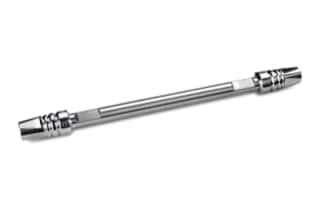
|
Chemistry |
C18 |
|
Separation Mode |
Reversed Phase |
|
Particle Substrate |
Hybrid |
|
pH Range Min |
1 pH |
|
pH Range Max |
12 pH |
|
Maximum Pressure |
18000 psi (1240 Bar) |
|
Endcapped |
Yes |
|
Silanol Activity |
Low |
|
Particle Shape |
Spherical |
|
Particle Size |
2.5 µm |
|
Endfitting Type |
Parker-style |
|
Pore Size |
130 Å |
|
Format |
Column |
|
Surface Area |
185 |
|
System |
UPLC, UHPLC |
|
Particle Technology |
BEH |
|
USP Classification |
L1 |
|
Inner Diameter |
2.1 mm |
|
Length |
75 mm |
|
Carbon Load |
18 % |
|
eCord |
Yes |
|
UNSPSC |
41115709 |
|
Brand |
XBridge |
|
Product Type |
Columns |
|
Units per Package |
1 pk |

XBridge BEH C18 XP Column, 130Å, 2.5 µm, 2.1 mm X 75 mm, 1/pk
When compared to columns with traditional packing materials, the XBridge BEH C18 XP Column demonstrates extremely little retention loss or peak shape degradation. This is due to the fact that the XBridge packing uses proprietary bonding and end-capping methods, resulting in ligand stability and chromatographic repeatability even at low pH. This also means that without sterically limiting the stationary phase, the XBridge BEH C18 XP Column provides remarkable column longevity. The XBridge BEH C18 XP Column's combination of BEH particle synthesis with improved bonding and end-capping technology makes it extremely robust under high pH circumstances, making it a highly sought-after piece of scientific equipment.
Make use of the XBridge BEH C18 sorbent over the whole range of mobile phase pH, making it a workhorse for HPLC method development. The C18 ligand is trifunctionally linked to provide a universal column for most HPLC separations, with the largest pH range, excellent low pH stability, and ultra-low column bleed. 2.5 µm eXtended Performance [XP] columns, packed in ultra-low dispersion hardware, provide superior separation performance, resilience, and throughput for HPLC tests while allowing for a smooth transition to UPLC adoption.
With the XBridge BEH C18 XP Column, you can simply adapt techniques from HPLC to UPLC and from UPLC to HPLC. For HPLC experiments, the XBridge BEH C18 XP (eXtended Performance) Column provides superior separation performance, resilience, and throughput. It's made to endure high pressures while still producing good results. The listing here is one of the many configurations of the XBridge analytical column available. You can find the other variants and also shop for lab equipment using our website.
Protect your analytical column and enhance its performance by using the Waters XBridge BEH C18 XP VanGuard Cartridge, 130Å, 2.5 µm, 2.1 mm X 5 mm, 3/pk.
What Is The pH Range Offered By The XBridge BEH C18 XP Column?
The XBridge BEH C18 XP Column listed here offers a wide operating pH Range of 1-12 pH.
What Is The Maximum Pressure That The XBridge BEH C18 XP Column Can Work With?
The XBridge BEH C18 XP Column listed here can comfortably take up to 18000 psi (1240 Bar) pressure, given that the other limits of temperature and buffers are observed.